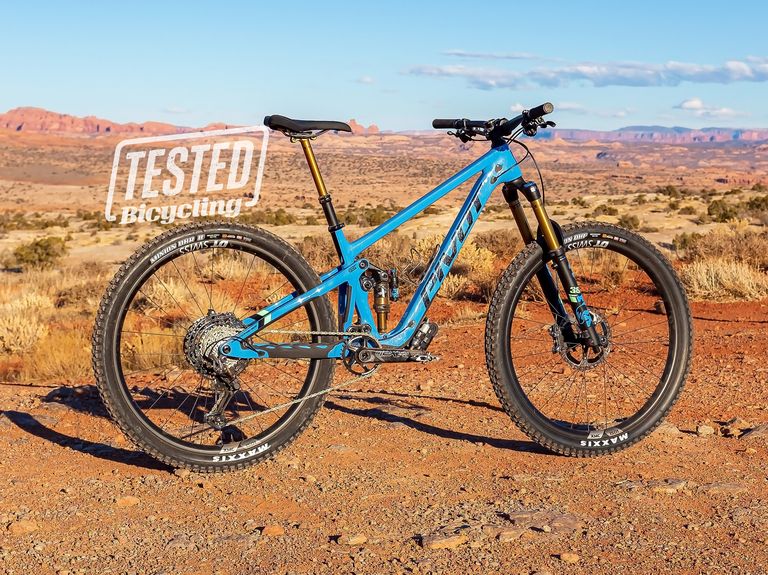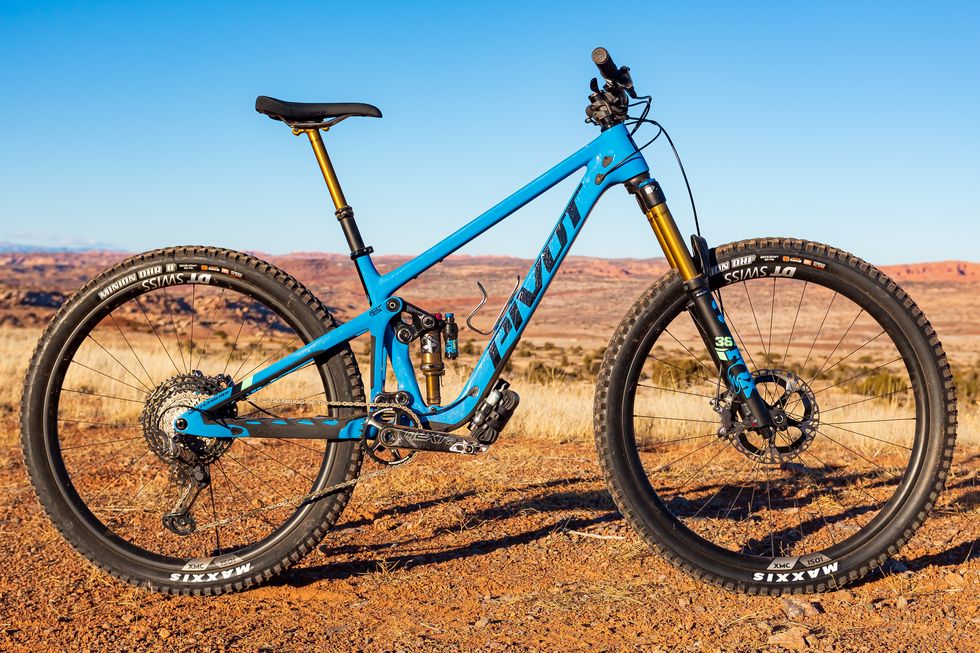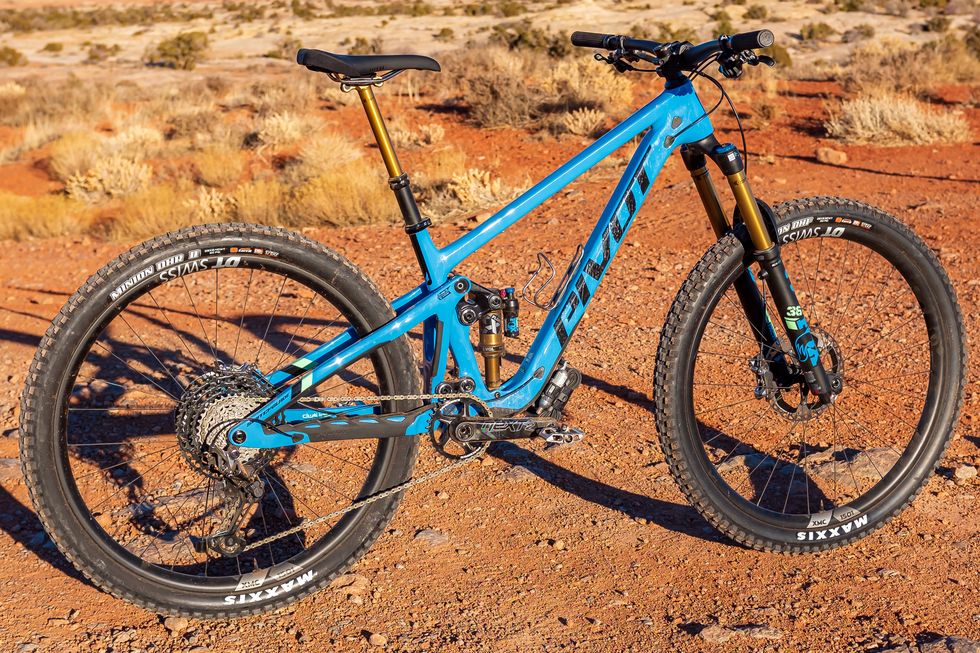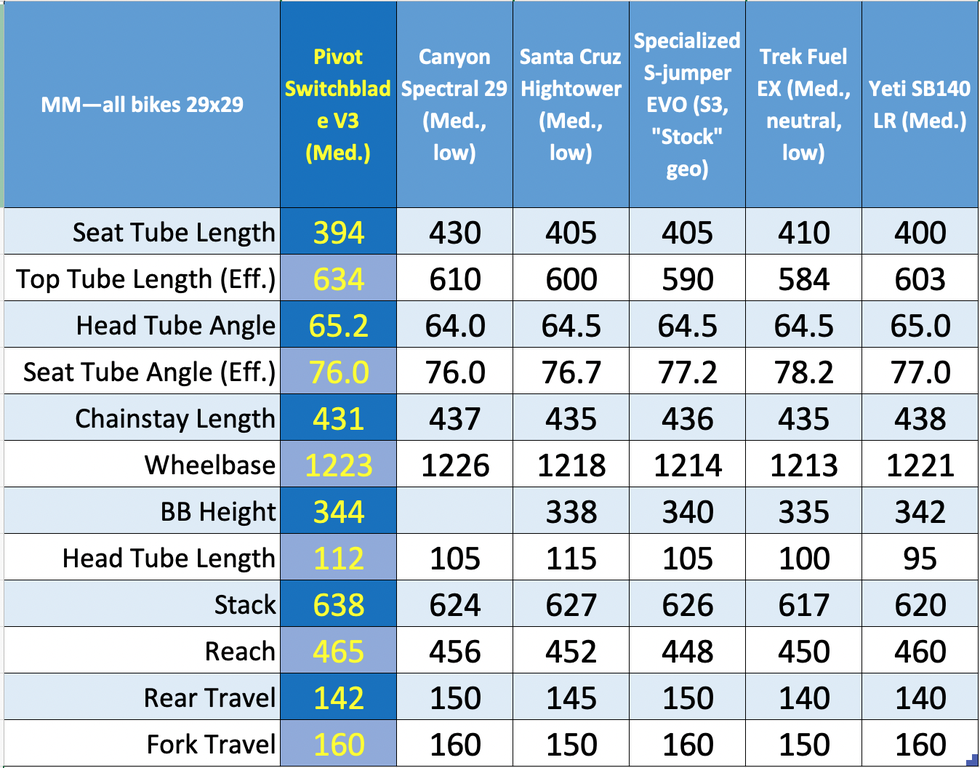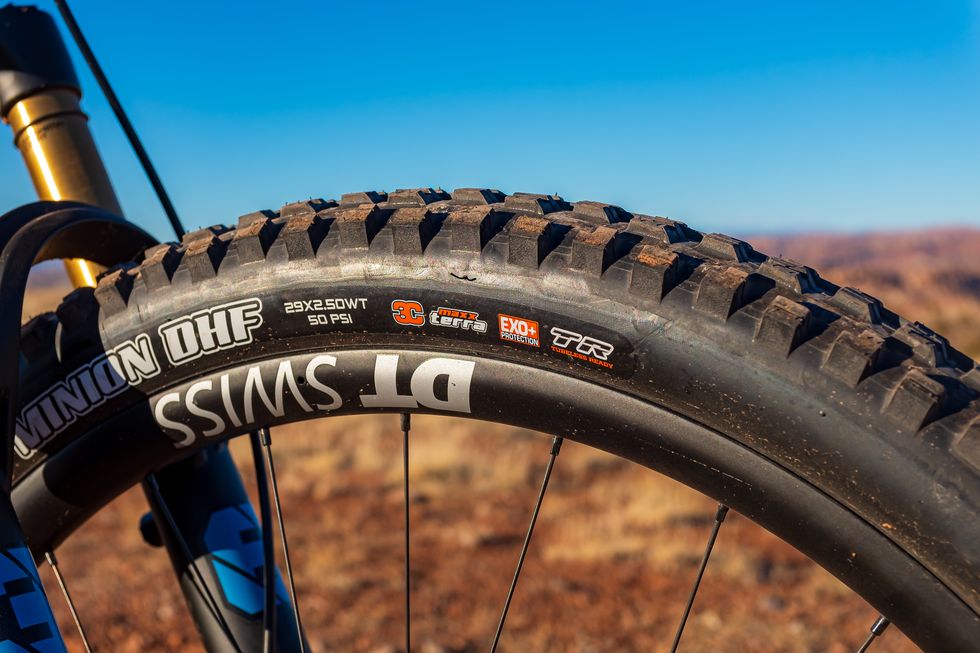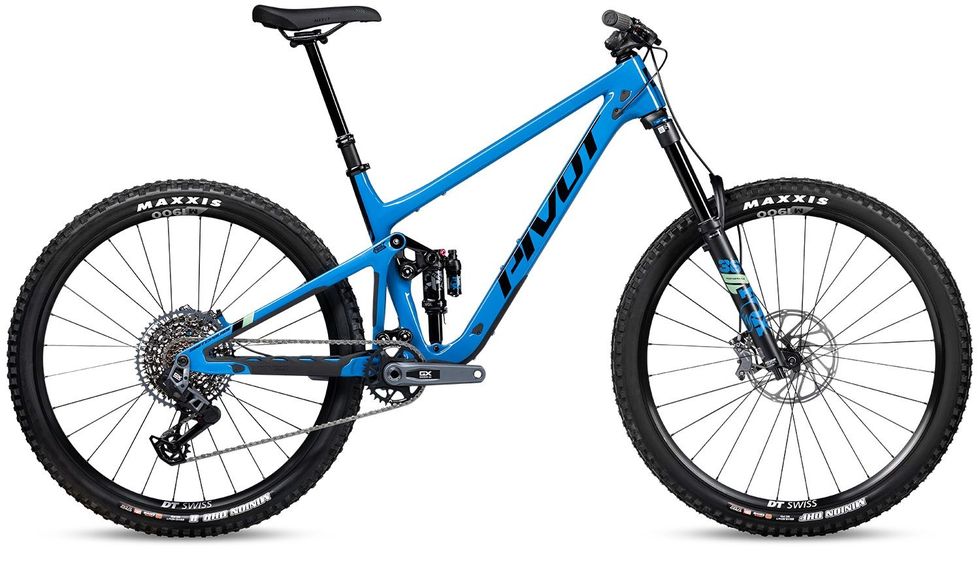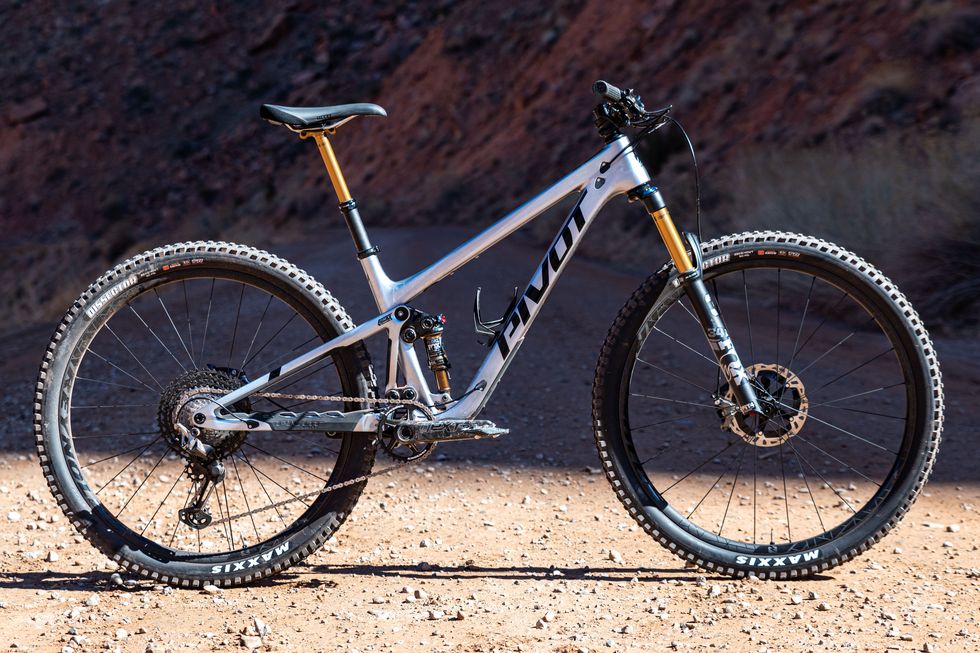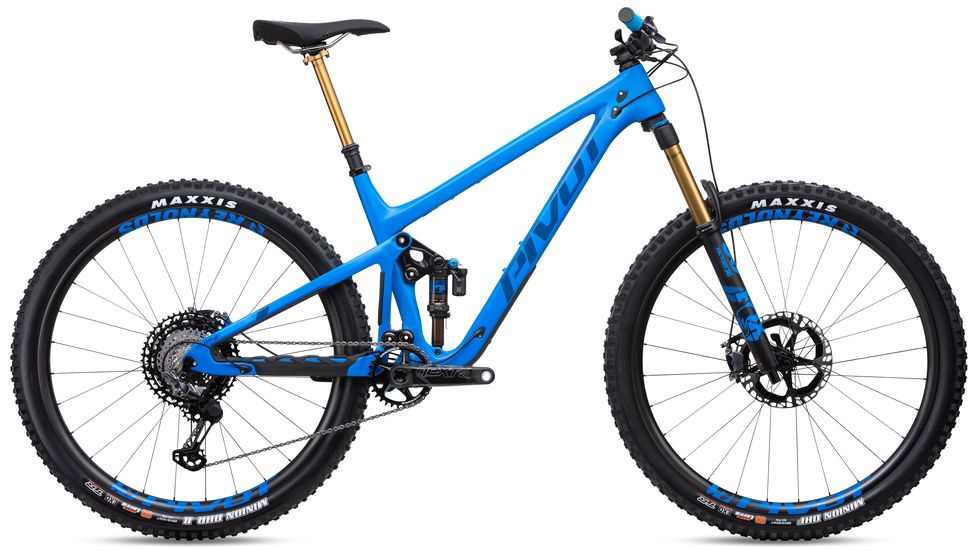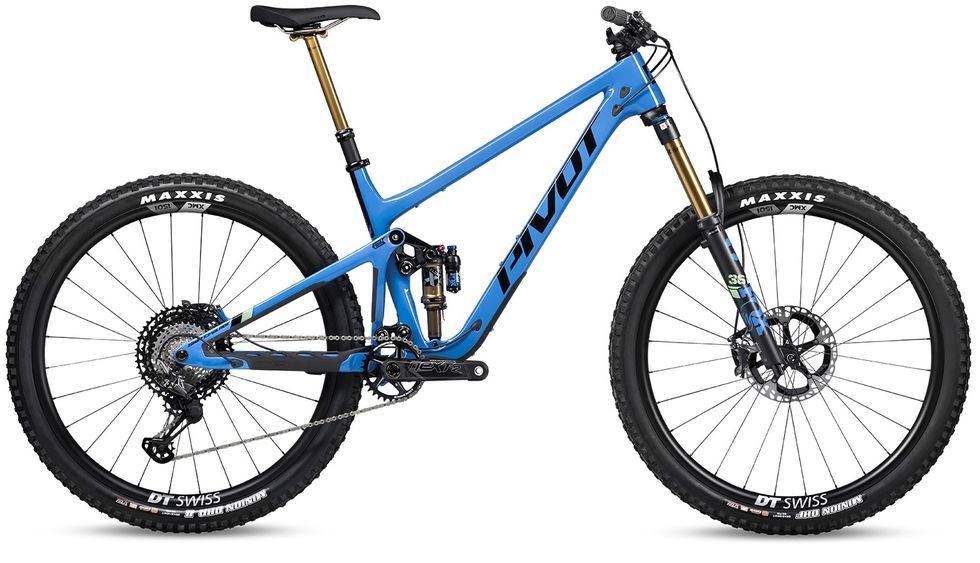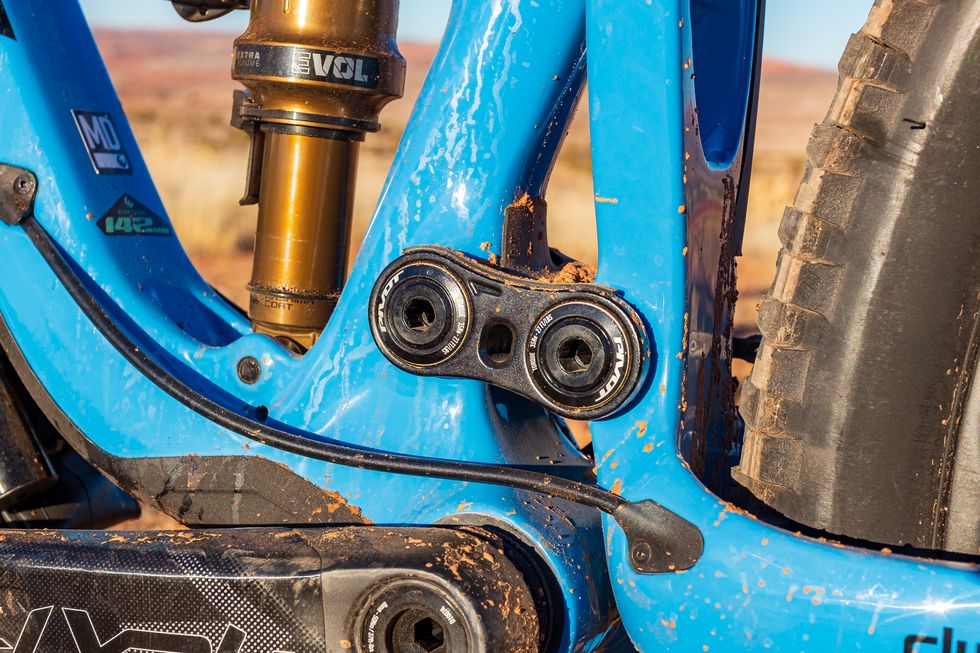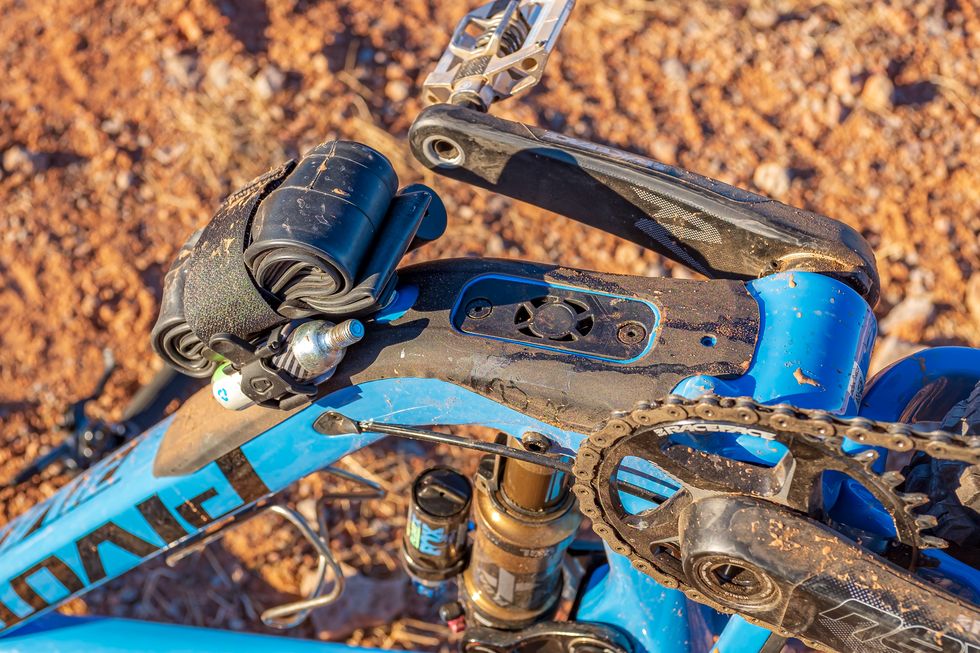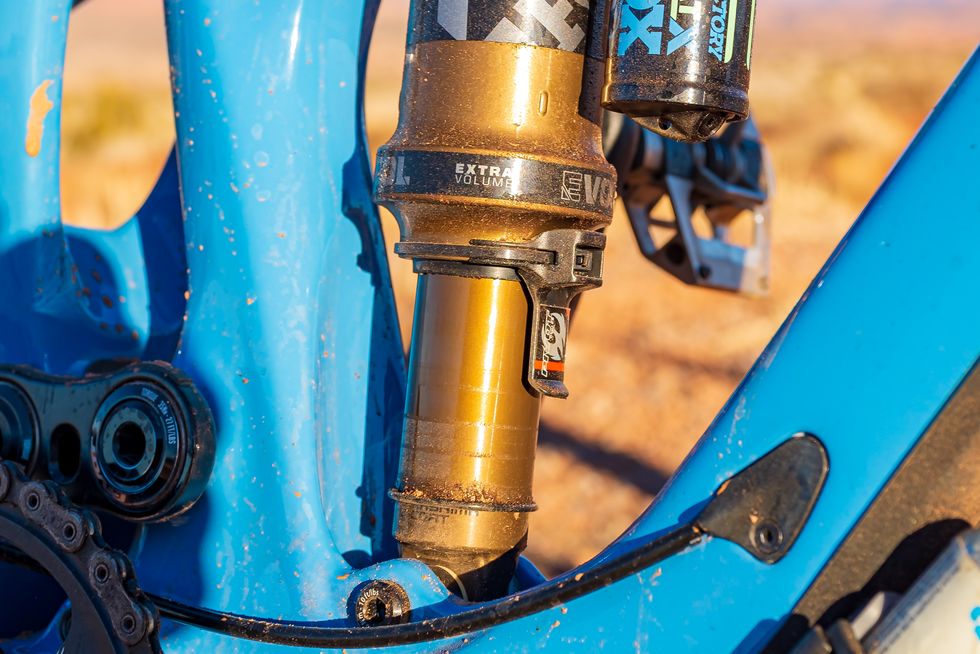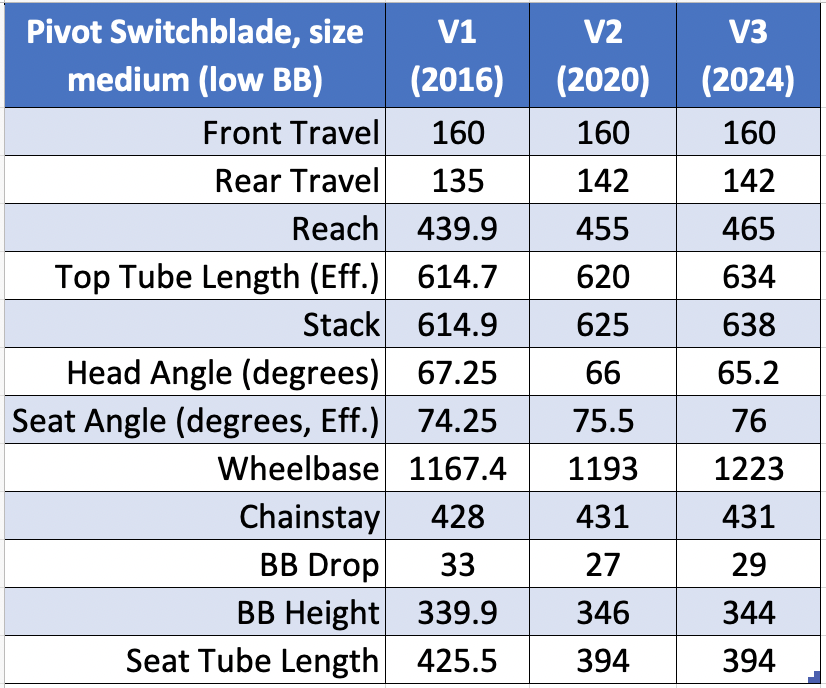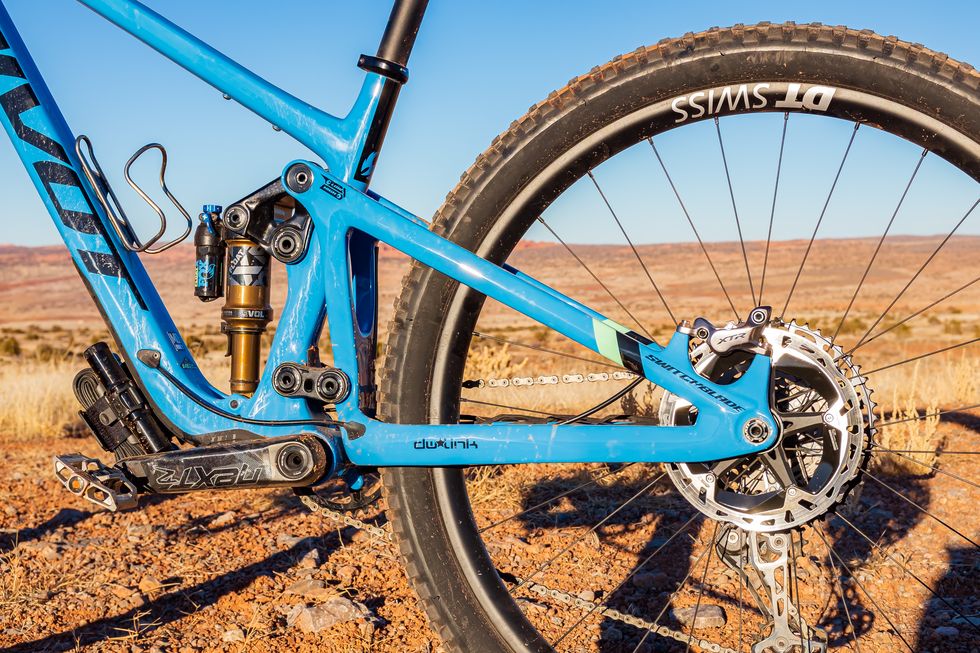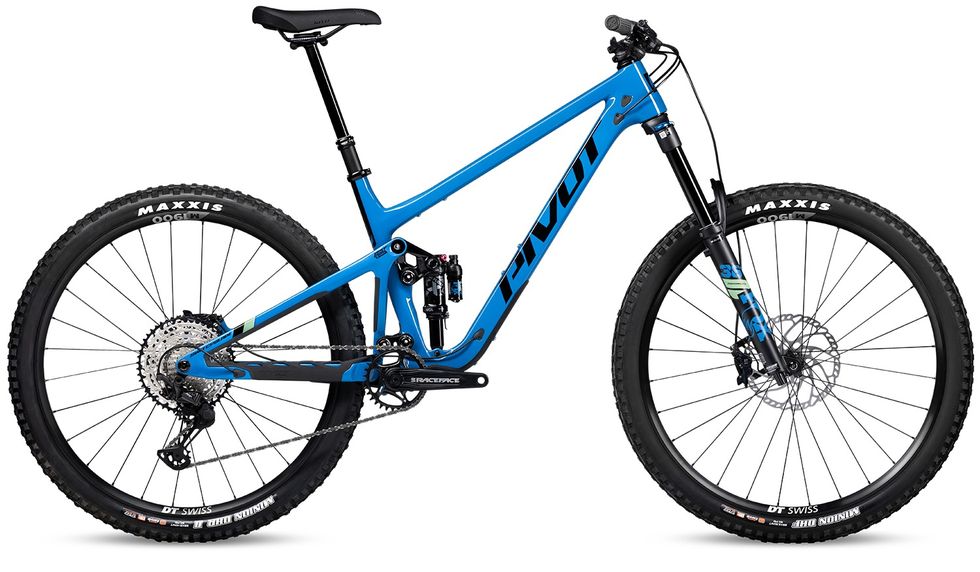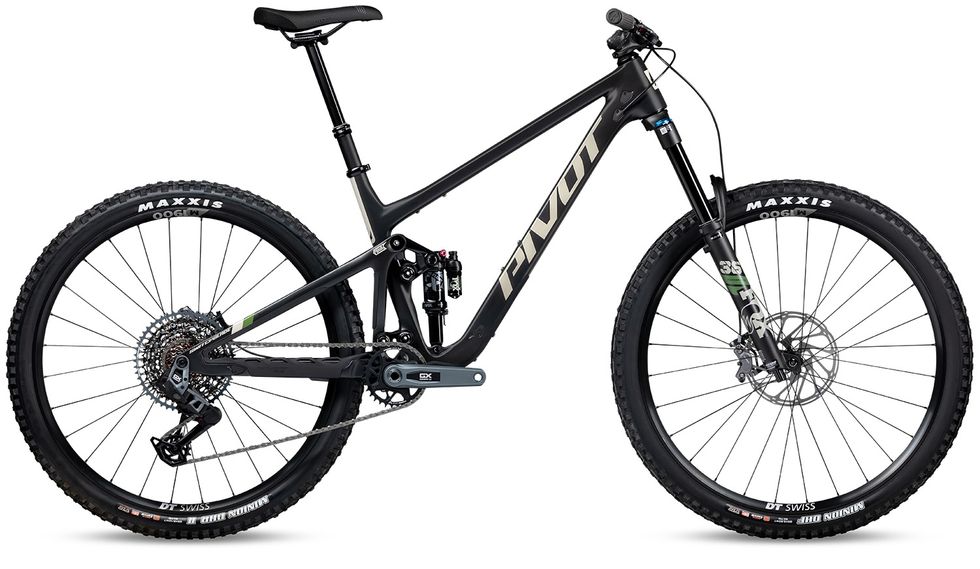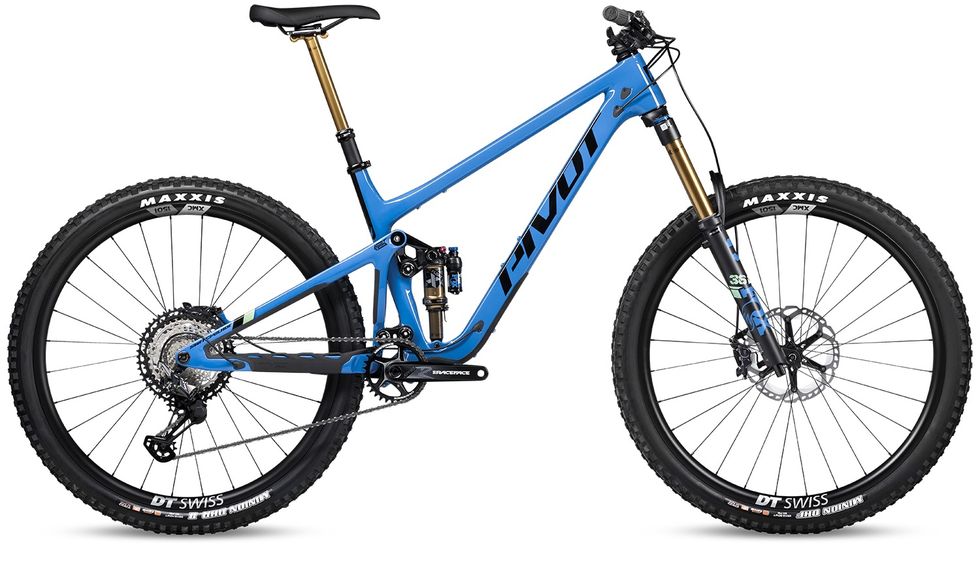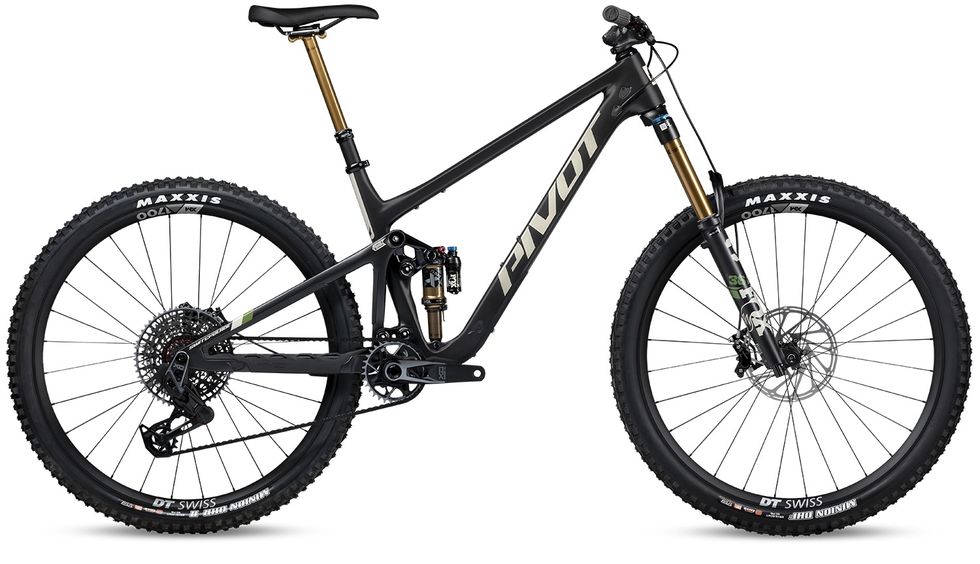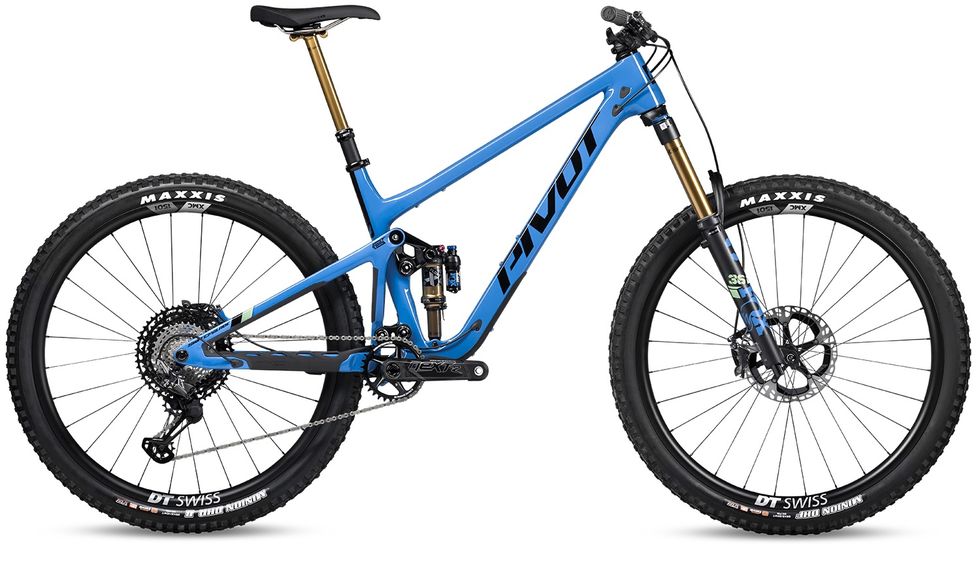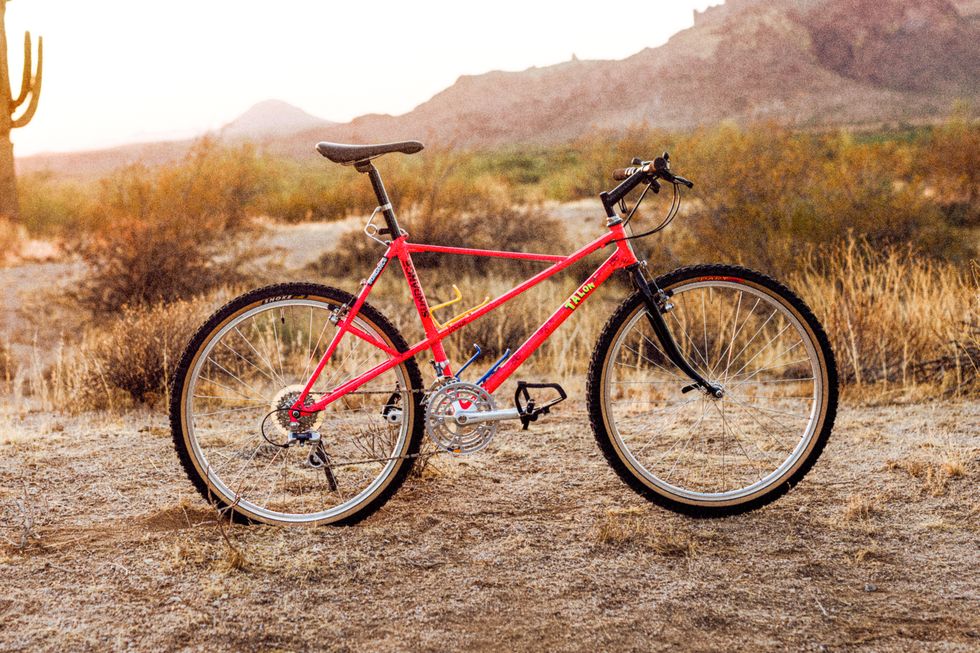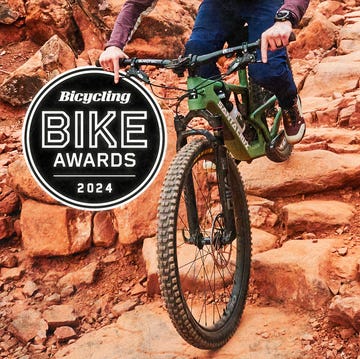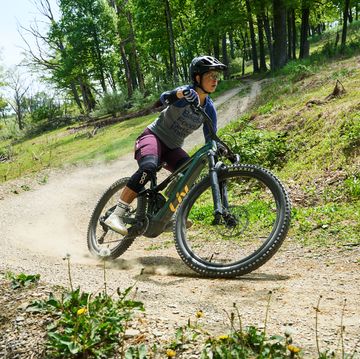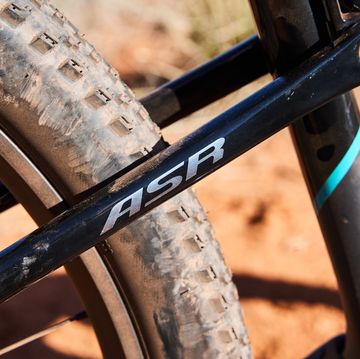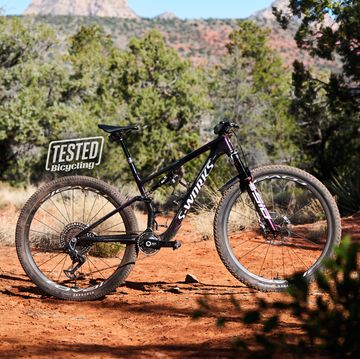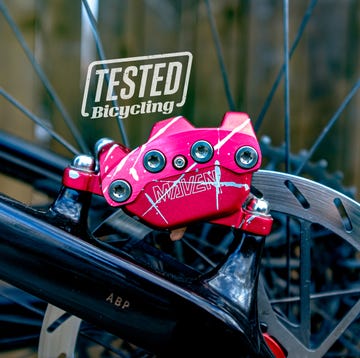The Takeaway: Pivot’s Switchblade trail bike is aimed at the heart of mountain biking: A bike for busting out rides after work, weekend trips to the bike park, or vacations in Sedona or Whistler. Reflecting the evolution of the sport, the new third-generation model features more stability, and the suspension is more capable in rough terrain. The riding position is long—some of the longest reach and top tube measurements you will find—but the handling remains reactive. The suspension is more forgiving and better at absorbing square edge bumps without losing the efficient feel you expect from a Pivot.
Ride Impressions
As is often the case with deep-winter bike launches in the northern hemisphere, my time aboard the new Switchblade was more limited than I’d prefer. Still, I had enough time riding the Switchblade on familiar trails to get a well-rounded picture of the new bike.
I try to consider every bike on its merits, but the V2 Switchblade is one of my favorite mountain bikes—one I’ve ridden extensively. So, I can’t help compare the V3 to the V2.
Like the V2, the Switchblade V3 aligns with the fat heart of mountain bike riding. It’s efficient enough for long rides and agile enough for flatter terrain. Yet the bike offers the capability for more demanding terrain and higher speeds.
Reflecting how mountain biking continues to evolve, getting faster and more demanding each year, the V3 is more bike than the V2. And it’s notably smoother and more stable. I didn’t consider using the V2 Switchblade for even occasional bike park riding or enduro racing—The V3 is absolutely up to those tasks.
The V3 is better at holding speed through choppy terrain, more composed when the rider pushes to their limits and offers better traction in turns. It also has better rear wheel traction on technical climbs than the V2.
But it’s hard to make a bike better at high speeds and make the suspension more effective in rough terrain—as the V3 is—without compromise. While I think Pivot has done a very good job of minimizing the compromise, the V3, compared to the V2, does feel slightly less crisp and efficient on smoother climbs, and its reactivity is slightly dulled on less demanding trails.
That said, the V2 Switchblade was slightly anomalous. It had a little sharper handling and crisper feeling than other popular bikes in the 150 mm-ish travel category (which means 140-150mm rear travel with a 150 or 160mm fork). Meanwhile, the V3’s performance is more in line with where the category is now and appears to be heading.
Frankly, if you’re looking for a bike that rides like a V2 Switchblade, I think you’re now more likely to find that in modern 120/130mm bikes like Pivot’s Trail 429 or a Norco Fluid FS.
However, as I said, the new Switchblade is more aligned with other bikes in its travel category. It’s ready to compete with (and potentially exceed in some situations) the Specialized Stumpjumper Evo, Trek Fuel EX, Canyon Spectral 29, Santa Cruz Hightower, Yeti SB140 LR, and many other great bikes in this space.
Here’s a geo table comparing the five bikes I mentioned to the new Switchblade if you want to get into the weeds:
I find it interesting how the Switchblade’s steeper head angle and short stays temper the wheelbase: Even though the top tube length is quite a bit longer than the other bikes, the wheelbase doesn’t grow as outrageously. Example: The Switchblade’s top tube is 50mm (!) longer than the Trek Fuel EX (front center grows with top tube length), yet the Trek’s wheelbase is just 10mm shorter.
Perhaps that’s why the Switchblade’s riding position felt long when I was on the trail. But the bike didn’t handle long. When I first hopped on the bike, I felt like maybe the medium was too big (even after I swapped on a 10mm shorter stem). However, once I got up to speed, the reasonable wheelbase and steeper head angle helped make the bike more flickable and lighter steering than I anticipated.
Consequently, I found the Switchblade had the stability first feel and steep terrain capability of many other bikes in its category but with just a touch more spice to its reactions.
I’d also say the V3 Switchblade’s suspension feel trends slightly more mainstream than previous Pivots. dw-Link suspension typically has a crisper and sportier feel. And Pivot’s bikes were often tuned slightly crisper still than other dw bikes.
The new Switchblade feels smoother, softer, almost plush. It’s a floatier ride that flutters through chop and takes the sting out of square-edged hits. It does so without a negative effect on control or the rider’s ability to pick the bike off the trail surface at will.
Overall, I think the new Switchblade is highly successful because it moves away from the slightly quirky character of the previous generation—and to be clear, the quirks were why I loved the V2 so much—and towards a bike with a more mainstream feel to its suspension and handling, and with the enhanced capability riders in this space demand.
But it is still a Pivot, which means it is a highly refined bike created by detail-oriented obsessives for the demanding connoisseur.
Switchblade Weight
Let’s talk bike weight. Pivot sent me the Team XTR, which, based on my survey of the available builds), is the lightest build. My medium-sized sample weighs 30.3 pounds (I weigh all bikes without pedals, bottle cages, computer mounts, bells, etc.). The Team XTR in XS and S might squeak under the 30-pound mark, but most Switchblades will weigh more than 30 pounds.
So, even spending ten grand on a Switchblade with top-of-the-line everything likely won’t get you a sub-30 pound bike.
I’m not picking on Pivot here: Mountain bike weights have been trending upward for years. And with the increased weight, we have better riding, more capable, more feature-rich, and (usually/hopefully) more reliable bikes.
Because I test so much equipment, I’m used to riding a heavier bike. And my (admittedly silly) personal mountain bike weighs nearly 37 pounds, so the Switchblade felt light to me.
But I hear many riders grumbling about how heavy mountain bikes are nowadays. If you’re concerned about weight, the best choice, as always, is to ride a bike with less travel.
Pivot’s Trail 429 (120mm rear, 130mm front travel) Team XTR is over 27 pounds on my scale, or about three pounds lighter than a Switchblade with a similar level of parts. You’ll need to drop down to a 100mm travel bike like Pivot’s Mach 4 SL (24.4 pounds on my scale) to get lighter.
Again, those weights are based on extremely high-end builds, so add weight if you buy a lower-grade parts kit.
Having lived through the days of 26-pound trail bikes on the verge of exploding every ride, I’m happy to ride a modern 30-pound bike as capable and reliable as this Switchblade.
But if you prioritize riding a light bike, a modern trail sled like the Switchblade isn’t for you.
What’s New
See if you can spot the differences (other than color and graphics) in the pictures of the V2 and V3 generations of Switchblade below.
Here’s the V2:
And here is a V3:
Really similar, right? The two bikes are so similar that when I pulled my V3 test bike out of the box, I thought Pivot perhaps accidentally sent the old bike.
Here’s a GIF that flips between V2 and V3. It helps illustrate how similar the generations are, but you can also see the geometry changes, plus the suspension link and pivot point alterations.
Pivot kept many things the same, including travel—which remains at 142mm rear and 160mm in front. But while Switchblades V2 and V3 look the same, they are very different bikes.
“We wanted to maintain the same snappy pedaling and poppy liveliness of the V1/V2 Switchblades with the new one,” Chris Cocalis, Pivot’s founder and CEO told me, “However, the goal was to make the bike more capable in true enduro type terrain.”
Pivot made substantial changes to the Switchblade’s geometry (more below) to make it more capable. The new bike gets more reach, a longer top tube, a slacker head angle, a longer wheelbase, a slightly lower bottom bracket, and a steeper seat tube angle. Chainstay lengths also got a refinement: XS, S, and M frames run 431mm chainstays, the L gets 432mm stays, and the XL gets 436mm stays.
The rear suspension gets a rework as well. Both links are new—the lower link is notably longer—and Pivot’s *erm* pivot bores change, also.
Explaining the suspension changes, Cocalis told me, “[The V3 Switchblade] has a more rearward path than the previous version which allows the bike to flow through repeated bumps better as well as taking sharper/bigger hits without upsetting the chassis. The flip side of this is that the new setup generates more traction on steep climbs. The harder you push the pedals, the better it sticks and accelerates up the climbs. On the descents, the bike is just a lot more composed, and the rider feels more confident at higher speeds and in more technical and choppy terrain.”
The damper tune does not change. However, the Switchblade’s new kinematics change how the linkage acts upon the damper. Effectively, it is a different shock tune even though, physically, it is not. If you want to get even more into the weeds, Pivot did change the stock air volume spacer from the V2’s 0.7 in3 to 0.4 in3. Again, the kinematics are different, so shock rates are different, so then-versus-now volume spacer size is not a blueberries-to-blueberries comparison.
Since the bikes look so similar and run the same shock tune, I asked Cocalis, “Is it possible to mount the V3 links to a V2 frame?” Cocalis responded that although it is “technically” possible, the result “wouldn’t be good” because the pivot bores are in different locations.
Although lab-tested stiffness numbers are the same from a V2 to a V3 frame, the V3 frames are about 15 grams lighter. Considering the V3 is also longer—longer is typically heavier and less stiff—that’s a notable accomplishment.
What’s Not New
As is obvious from the V2 and V3 photos, Pivot carried over many of the V2’s features. Why wouldn’t they? The V2 was an awesome bike.
Many of the carry-forward features are common to most Pivot mountain bikes. These features include the clamping cable port system, press-fit 86 bottom bracket standard, and Super Boost Plus (12x157mm) rear wheel spacing. Like the previous version, the V3 Switchblade has multiple mounts: A waterbottle mount on top of the down tube, a cargo mount under the top tube, a waterbottle/cargo mount under the down tube, and a mount just ahead of the BB shell under specifically for the Pivot/Topeak Dock collaboration tools and accessories.
Although the first batches of the V2 Switchblade had Pivot’s replaceable rear dropout, a running change saw the V2 frame get SRAM’s UDH rear derailleur hanger. And, to nobody’s surprise, the V3 gets UDH.
Another gizmo on the Switchblade—and found on all Pivot full suspension bikes with air shocks—is a clip-on sag gauge. This little gizmo greatly simplifies and speeds up the rear suspension setup. I don't know why more brands don’t use something similar.
Geometry
Typical Pivot geometry is already on the longer end of the scale. But the new Switchblade is even longer still. Reach and top tube lengths are up about a centimeter, and, combined with an almost one-degree slacker head angle, the wheelbase also gets longer (30mm longer on the size medium I ride). The size small V3 has the same length wheelbase as the previous generation in a medium (1223mm).
Below is a look at how the Switchblade’s geometry has evolved over eight years and three generations.
Consequently, the new Switchblade looks like a long bike on paper, with, per size, some of the rangiest reaches and effective top tube lengths you’ll find.
I’ve always liked a longer bike. Historically, I’ve been very happy aboard a medium Pivot (I’m a touch over 5’8” tall). But the V3 medium, with its 634mm effective top tube length, approaches too long even after I swapped the stock 45mm stem for a 35mm.
It’s not that the size medium’s length was limiting me in any way (something, something climbing-and-descending Strava PRs, blah, blah), but rather it is a question of preference. How “in” versus “on” do I want to feel on a bike?
Like most performance mountain bikes today, the Switchblade’s dimensions allow many riders to step up or down a frame size to get the fit and feel they prefer. They’re also a reminder that modern frame size designations are arbitrary and that we should ignore small, medium, large, etc., and carefully consider a bike’s geometry table before settling on a size. And, as always, it’s best to sit on a bike to confirm that it fits properly. Even a short spin around a parking lot can help.
All complete Switchblades ship with matching 29-inch wheels. But it is, according to Pivot, compatible with a 27.5-inch rear wheel for riders who prefer a staggered/MX setup. Other than sourcing a rear wheel (with 157mm spacing, remember) and tire, Pivot recommends setting the flip chips in the seatstay to the high setting (the bike ships in the low setting) to offset the geometry changes caused by fitting a smaller diameter rear wheel.
Size Specific Specifics
The new Switchblade frame comes in five sizes (XS to XL) that, Pivot claims, cover riders from 4’11” to over 6’5” (149 cm to 196+ cm).
As well as altering frame dimensions, Pivot also “scales stiffness across all sizes” by adjusting tube dimensions and carbon layup to achieve “consistent performance metrics.”
There are two reasons for size-specific frame stiffness. One is that if carbon layup and tube dimensions are the same, smaller frames are naturally stiffer, and larger frames are softer. The other is that riders of smaller frames are often lighter weight, while taller riders often weigh more. The goal of size-specific tuning is to adjust the frames so that every rider (no matter the frame size they ride) experiences a similar feel and performance from the bike.
Pivot also adjusts the suspension based on frame size. “We optimize the kinematics for each frame size based on a rider’s center of gravity and average saddle height per size to ensure consistent suspension kinematics for every size rider,” it claims. The brand also states, “For bikes where chainstay length varies with size, suspension kinematics naturally change. However, we modify pivot points to ensure optimal curves for each size.”
Another size-specific change is the water bottle mount location. Pivot claims, “water bottle options are considered on a size-by-size basis, acknowledging the differences in available space inside and outside the frame for each size,” in the section of their site dedicated to its size-specific approach.
Pivot also makes a few component adjustments per size. The crank length changes slightly (XS, S, M-170mm and L, XL-175mm), as well as the bar width. The bar width is XS-760mm, SM, MD, LG-780mm, XL-800mm) for models with a carbon bar. Builds with an aluminum handlebar use a 780mm bar (XS, S, M, and LG) and 800mm (XL).
Dropper post also varies per size. For models with a RockShox Reverb AXS, the travels are XS-100mm travel, S-125mm, M-150mm, and LG/XL-170mm. For models with Fox Transfer, the travels are XS-125mm travel, S-150mm, M-175mm, and LG/XL-200mm.
Pivot makes a size-specific saddle adjustment too. XS and S bikes get a WTB High Tail Trail because it offers additional clearance to prevent the rear tire from buzzing the seat at maximum travel.
To be clear, Pivot is far from the only brand that applies a size-specific approach to frame, suspension tune, and components. On the other hand, it is not a universal approach, so I like to highlight it when a brand puts in the extra effort.
Builds and Prices
Pivot offers six V3 Switchblade builds with prices starting at $6,399 and topping out at $11,399.
As usual, Pivot kits out their bikes with Fox suspension (Float X shock, 36 fork) and Transfer dropper post (except the most expensive build, which runs a RockShox Reverb AXS), Maxxis tires (the trusty Minion DHF/DHR II combo) with EXO+ casings, Pivot branded bar, stem, and grips, WTB saddles, and DT-Swiss wheels. Pro-level builds have a carbon wheel upgrade option. The stock wheelset is DT’s XM1700; stepping up to the carbon XMC5101 runs an extra $1,200.
Ride SLX/XT—$6,399
Fox Performance 36 GRIP fork
Fox Performance Float X shock
Fox Performance Elite Transfer dropper post
Shimano SLX shifter, cassette, chain
Shimano XT rear derailleur
Race Face Ride crank
Shimano SLX disc brakes (203/180mm rotors)
DT Swiss XM1900 wheels
Phoenix Team Low Rise aluminum handlebar
Ride GX AXS Transmission—$6,999
Fox Performance 36 GRIP fork
Fox Performance Float X shock
Fox Performance Elite Transfer dropper post
SRAM GX AXS Eagle Transmission rear derailleur, chain, cassette, crank
SRAM AXS Pod Controller
SRAM Code R disc brakes (200/180mm rotors)
DT Swiss XM1900 wheels
Phoenix Team Low Rise aluminum handlebar
Pro XT/XTR—$7,799 ($8,999 with carbon wheel upgrade)
Fox Factory 36 GRIP2 fork
Fox Factory Float X shock
Fox Factory Transfer dropper post
Shimano XT shifter, cassette, chain
Shimano XTR rear derailleur
Race Face Aeffect R crank
Shimano XT disc brakes (203/180mm rotors)
DT Swiss XM1700 wheels (stock)
DT Swiss XMC1501 wheels (upgrade)
Phoenix Team Low Rise Carbon handlebar
Pro X0 AXS Transmission—$8,699 ($9,899 with carbon wheel upgrade)
Fox Factory 36 GRIP2 fork
Fox Factory Float X shock
Fox Factory Transfer dropper post
SRAM X0 AXS Eagle Transmission rear derailleur, chain, cassette, crank
SRAM AXS Pod Controller
SRAM Code RSC disc brakes (200/180mm rotors)
DT Swiss XM1700 wheels (stock)
DT Swiss XMC1501 wheels (upgrade)
Phoenix Team Low Rise Carbon handlebar
Team XTR—$9,899
Fox Factory 36 GRIP2 fork
Fox Factory Float X shock
Fox Factory Transfer dropper post
Shimano XTR derailleur, shifter, cassette, chain
Race Face NEXT R crank
Shimano XTR disc brakes (203/180mm rotors)
DT Swiss XMC1501 wheels
Phoenix Team Low Rise Carbon handlebar
Team XX AXS Transmission—$11,399
Fox Factory 36 GRIP2 fork
Fox Factory Float X shock
RockShox Reverb AXS dropper post
SRAM XX AXS Eagle Transmission rear derailleur, chain, cassette, crank
SRAM AXS Pod Ultimate Controller
SRAM Code Ultimate Stealth disc brakes (200/180mm rotors)
DT Swiss XMC1501 wheels
Phoenix Team Low Rise Carbon handlebar
35th Anniversary Talon Edition
About 35 years ago, Pivot’s Founder and CEO Chris Cocalis launched his first bike brand, Sun Eagle, and the Talon mountain bike.
Pivot is offering a limited number of Talon editions of the new Switchblade to celebrate this milestone. Only the color and graphics change, and you’ll pay $200 more for the privilege of owning one of the limited-edition models.
Distinguished by their fluorescent pink paint and retro graphics, Talon editions are offered in four builds: Pro XT/XTR ($9,199), Pro X0 AXS Transmission ($10,099), Team XTR ($10,999), Team XX AXS Transmission($11,599).
The parts are the same whether you buy a standard or Talon edition. There is, however, a small caveat—no wheel upgrade for the Talon Pro builds. They’re only offered with the more expensive carbon wheels.

A gear editor for his entire career, Matt’s journey to becoming a leading cycling tech journalist started in 1995, and he’s been at it ever since; likely riding more cycling equipment than anyone on the planet along the way. Previous to his time with Bicycling, Matt worked in bike shops as a service manager, mechanic, and sales person. Based in Durango, Colorado, he enjoys riding and testing any and all kinds of bikes, so you’re just as likely to see him on a road bike dressed in Lycra at a Tuesday night worlds ride as you are to find him dressed in a full face helmet and pads riding a bike park on an enduro bike. He doesn’t race often, but he’s game for anything; having entered road races, criteriums, trials competitions, dual slalom, downhill races, enduros, stage races, short track, time trials, and gran fondos. Next up on his to-do list: a multi day bikepacking trip, and an e-bike race.
